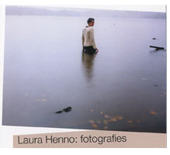- Exhibition program
- Cycle: Once upon a time?
- Artist
- Laura Henno
- Dates
- —
- Curated by
- Marie-Thérèse Champesme i Pascale Pronnier
Those who have already seen a total eclipse of the sun will remember that disturbing and fascinating moment which precedes the coming of the darkness: animals fall silent and stand still , everything seems to stop and wait. We feel something similar when looking at the photographs of Laura Henno ( France , 1976) , an impression that time has been suspended , frozen , and that , in that in-between , beings are in the grip of an invisible , mysterious force.
In the interior scenes , we invade the privacy of adolescents cut off from the world , isolated in their reverie , immobilised by melancholy. In the Bed series she evokes the fragility of these young girls at the moment of their physical metamorphosis. In other images , however , the young women seem to have been suddenly halted in their movement. But in both cases the person seems to be giving herself up to the environment , letting herself be absorbed , swallowed: the adolescent in Bed 1 has nestled on the eiderdown and the one in Bed 3 is half hidden under her bed , doubtless hoping to find shelter there , whilst the character in Freezing is sinking slowly into a dense , cloudy water.
In these images we can deduce the work the photographer does with her models to find the exact position where the body slides into its envelope and becomes one with the environment. The landscapes that are empty of any human presence also seem to be waiting , unless life is hiding there and we have not yet managed to discern it.
The young girls presented in Henno's images clearly appear to us as ‘characters' out of a narrative. But we shall know nothing of their story, of what they are looking at, of what they are thinking about. And sometimes we shall not even know their faces, because they turn their backs on us or are half hidden in the darkness. Indeed, her photographs are often constructed on strong chiaroscuro contrasts with the figure alone in the light and what is around it left deliberately in the shadows. Even if the scene is lit, as in Freezing where the pale light bathes the landscape in a glacial whiteness, what remains is what one might call “the out of field mystery”, the conviction that something is there, of which we know nothing, which exercises an irresistible attraction over the person.
The quality of Henno's work is undoubtedly due to both her immense modesty and her fabulous ambition: not to try to seize, in a ‘decisive instant' what the personality, the ‘soul' of a person would be, but, going beyond the incident and leaving in the shadows or the unspoken, to manage to keep the mystery of places and beings intact.


